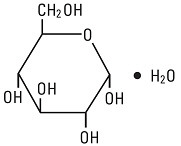DEXTROSE injection, solution
Dextrose by
Drug Labeling and Warnings
Dextrose by is a Prescription medication manufactured, distributed, or labeled by ICU Medical Inc.. Drug facts, warnings, and ingredients follow.
Drug Details [pdf]
-
HIGHLIGHTS OF PRESCRIBING INFORMATION
These highlights do not include all the information needed to use DEXTROSE INJECTION 20%, 30%, 40%, 50% and 70% safely and effectively. See full prescribing information for DEXTROSE INJECTION 20%, 30%, 40%, 50% and 70%.
DEXTROSE injection, for intravenous use
Initial U.S. Approval: 1940INDICATIONS AND USAGE
Dextrose Injection 20%, 30%, 40%, 50% and 70%, mixed with amino acids or other compatible intravenous fluids, is indicated as a source of calories for patients requiring parenteral nutrition when oral or enteral nutrition is not possible, insufficient or contraindicated (1)
DOSAGE AND ADMINISTRATION
- Must be diluted with compatible intravenous fluids or used as admixture, prior to administration. Not for direct intravenous infusion. (2.1)
-
Only for slow intravenous infusion only into a: (2.1)
- o Central vein, if final dextrose concentration is greater than 5% or osmolality is greater than 900 mOsm/L
- o Peripheral vein, if final dextrose concentration 5% or less and osmolality is less than 900 mOsm/L
- Individualize dosage based on the patient's clinical condition, body weight, nutritional/fluid requirements, as well as additional energy given orally/enterally (2.2)
- Discontinue infusion of concentrated dextrose solutions slowly and/or administer 5% dextrose (2.3)
DOSAGE FORMS AND STRENGTHS
Injection: Single-dose, partial-fill, flexible containers with (3):
500 mL fill volume in 1000 mL flexible container:
- 20% (0.2 grams/mL): 20 grams of dextrose hydrous per 100 mL
- 30% (0.3 grams/mL): 30 grams of dextrose hydrous per 100 mL
- 40% (0.4 grams/mL): 40 grams of dextrose hydrous per 100 mL
- 50% (0.5 grams/mL): 50 grams of dextrose hydrous per 100 mL
- 70% (0.7 grams/mL): 70 grams of dextrose hydrous per 100 mL
WARNINGS AND PRECAUTIONS
- Hyperglycemia or Hyperosmolar Hyperglycemic State: Monitor blood glucose and administer insulin as needed (5.1)
- Hypersensitivity Reactions: Monitor for signs and symptoms and discontinue infusion if reactions occur (5.2)
- Risk of Infection: Monitor for signs and symptoms and laboratory parameters (5.3)
- Refeeding Syndrome: Monitory laboratory parameters (5.4)
- Vein Damage and Thrombosis: Administer solutions containing more than 5% dextrose as the final concentration or solutions with an osmolarity ≥ 900 mOsm/L through a central vein (2.1, 5.5)
- Aluminum Toxicity: Dextrose Injection contains aluminum that may be toxic. Patients with impaired renal function, and preterm infants, at higher risk. Limit aluminum to less than 4 mcg/kg/day (5.6, 8.4)
- Parenteral Nutrition Associated Liver Disease: increased risk in patients who receive parenteral nutrition for extended periods of time, especially preterm infants; monitor liver function tests, if abnormalities occur consider discontinuation or dosage reduction. (5.7, 8.4)
- Electrolyte Imbalance and Fluid Overload: monitor daily fluid balance, blood electrolyte levels, correct as needed. (5.8, 8.4)
ADVERSE REACTIONS
The most common adverse reactions are hyperosmolar syndrome, infection both systemic and at the injection site, vein thrombosis or phlebitis, and hypervolemia. (6)
To report SUSPECTED ADVERSE REACTIONS, contact ICU Medical, Inc. at 1-800-441-4100, or FDA at 1-800-FDA-1088 or www.fda.gov/medwatch.
USE IN SPECIFIC POPULATIONS
Pediatric Use: Increased risk of hypoglycemia/hyperglycemia; monitor serum glucose concentrations. (8.4)
See 17 for PATIENT COUNSELING INFORMATION.
Revised: 11/2018
-
Table of Contents
FULL PRESCRIBING INFORMATION: CONTENTS*
1 INDICATIONS AND USAGE
2 DOSAGE AND ADMINISTRATION
2.1 Important Preparation and Administration Instructions
2.2 Dosing Information
2.3 Discontinuation of Dextrose Injection
3 DOSAGE FORMS AND STRENGTHS
4 CONTRAINDICATIONS
5 WARNINGS AND PRECAUTIONS
5.1 Hyperglycemia and Hyperosmolar Hyperglycemic State
5.2 Hypersensitivity Reactions
5.3 Risk of Infections
5.4 Refeeding Syndrome
5.5 Vein Damage and Thrombosis
5.6 Aluminum Toxicity
5.7 Risk of Parenteral Nutrition Associated Liver Disease
5.8 Electrolyte Imbalance and Fluid Overload
6 ADVERSE REACTIONS
8 USE IN SPECIFIC POPULATIONS
8.1 Pregnancy
8.2 Lactation
8.4 Pediatric Use
8.5 Geriatric Use
10 OVERDOSAGE
11 DESCRIPTION
12 CLINICAL PHARMACOLOGY
12.1 Mechanism of Action
16 HOW SUPPLIED/STORAGE AND HANDLING
17 PATIENT COUNSELING INFORMATION
- * Sections or subsections omitted from the full prescribing information are not listed.
- 1 INDICATIONS AND USAGE
-
2 DOSAGE AND ADMINISTRATION
2.1 Important Preparation and Administration Instructions
Dextrose Injection is supplied in the following five strengths: 20%, 30%, 40%, 50% and 70% [see How Supplied/Storage and Handling (16)]. Prior to administration, Dextrose Injection must be diluted with other compatible intravenous fluids or used as an admixture with amino acids. It is not for direct intravenous infusion.
Preparation Prior to Administration
- Because additives may be incompatible, evaluate all additions to the plastic container for compatibility and stability of the resulting preparation. Consult with a pharmacist, if available. If it is deemed advisable to introduce additives, use aseptic technique and mix thoroughly.
- Inspect Dextrose Injection to ensure precipitates have not formed during the mixing or addition of additives. Discard the bag if precipitates are observed. Some opacity of the plastic container (due to moisture absorption during sterilization process) may be observed. This is normal and does not affect the solution quality or safety. The opacity will diminish gradually.
- Use promptly after admixing or dilution.
- For single use only; discard unused portion
Important Administration Instructions
- Set the vent to the closed position on a vented intravenous administration set to prevent air embolism.
- Use a dedicated line without any connections to avoid air embolism.
- Prior to infusion, visually inspect the diluted dextrose solution for particulate matter. The solution should be clear and there should be no precipitates. Do not administer unless solution is clear and container is undamaged.
- The choice of a central or peripheral venous route of infusion should depend on the osmolarity of the final infusate. Solutions with greater than 5% dextrose or with osmolarity of greater than or equal to 900 mOsm/L must be infused through a central catheter [see Warnings and Precautions (5.5)].
2.2 Dosing Information
Caution: Dextrose Injection is not for direct intravenous infusion. Prior to administration, Dextrose Injection must be diluted with other compatible intravenous fluids or used as an admixture with amino acids.
Individualize the dosage of Dextrose Injection based on the patient's clinical condition (ability to adequately metabolize dextrose), body weight, nutritional and fluid requirements, as well as additional energy given orally or enterally to the patient.
The administration rate should be governed, especially during the first few day of therapy, by the patient's tolerance to dextrose. Daily intake of amino acids and dextrose should be increased gradually to the maximum required dose as indicated by frequent determinations of blood glucose levels.
-
3 DOSAGE FORMS AND STRENGTHS
Dextrose Injection 20%, 30%, 40%, 50%, and 70% USP are sterile, non-pyrogenic, hypertonic solutions of dextrose in single-dose, partial-fill, flexible containers.
500 mL fill volume in 1000 mL flexible container
- 20% (0.2 grams/mL): 20 grams of dextrose hydrous per 100 mL
- 30% (0.3 grams/mL): 30 grams of dextrose hydrous per 100 mL
- 40% (0.4 grams/mL): 40 grams of dextrose hydrous per 100 mL
- 50% (0.5 grams/mL): 50 grams of dextrose hydrous per 100 mL
- 70% (0.7 grams/mL): 70 grams of dextrose hydrous per 100 mL
-
4 CONTRAINDICATIONS
The use of Dextrose Injection is contraindicated in patients:
- who are severely dehydrated as hypertonic dextrose solution can worsen the patient's hyperosmolar state.
- with known hypersensitivity to dextrose [see Warnings and Precautions (5.2)].
-
5 WARNINGS AND PRECAUTIONS
5.1 Hyperglycemia and Hyperosmolar Hyperglycemic State
The use of dextrose infusions in patients with diabetes mellitus or impaired glucose tolerance may worsen hyperglycemia. Administration of dextrose at a rate exceeding the patient's utilization rate may lead to hyperglycemia, coma, and death. Patients with underlying confusion and renal impairment who receive dextrose infusions, may be at greater risk of developing hyperosmolar hyperglycemic state. Monitor blood glucose levels and treat hyperglycemia to maintain optimum levels while administering Dextrose Injection. Insulin may be administered or adjusted to maintain optimal blood glucose levels during Dextrose Injection administration.
5.2 Hypersensitivity Reactions
Hypersensitivity reactions including anaphylaxis have been reported with dextrose infusions. Stop infusion immediately and treat patient accordingly if signs or symptoms of a hypersensitivity reaction develop. Signs or symptoms may include: tachypnea, dyspnea, hypoxia, bronchospasm, tachycardia, hypotension, cyanosis, vomiting, nausea, headache, sweating, dizziness, altered mentation, flushing, rash, urticaria, erythema, pyrexia, and chills.
5.3 Risk of Infections
Patients who require parenteral nutrition are at high risk of infections because the nutritional components of these solutions can support microbial growth. The risk of infection is increased in patients with malnutrition-associated immunosuppression, hyperglycemia exacerbated by dextrose infusion, long-term use and poor maintenance of intravenous catheters, or immunosuppressive effects of other concomitant conditions, drugs, or other components of the parenteral formulation (e.g., lipid emulsion).
To decrease the risk of infectious complications, ensure aseptic technique in catheter placement and maintenance, as well as aseptic technique in the preparation and administration of the nutritional formula.
Monitor for signs and symptoms (including fever and chills) of early infections, including laboratory test results (including leukocytosis and hyperglycemia) and frequent checks of the parenteral access device and insertion site for edema, redness and discharge.
5.4 Refeeding Syndrome
Refeeding severely undernourished patients may result in refeeding syndrome, characterized by the intracellular shift of potassium, phosphorus, and magnesium as the patient becomes anabolic. Thiamine deficiency and fluid retention may also develop. To prevent these complications, monitor severely undernourished patients and slowly increase nutrient intakes.
5.5 Vein Damage and Thrombosis
Dextrose Injection is for admixture with amino acids or dilution with other compatible intravenous fluids. It is not for direct intravenous infusion. Administer solutions containing more than 5% dextrose or with an osmolarity of ≥ 900 mOsm/L through a central vein [see Dosage and Administration (2.1)]. The infusion of hypertonic solutions into a peripheral vein may result in vein irritation, vein damage, and/or thrombosis. The primary complication of peripheral access is venous thrombophlebitis, which manifests as pain, erythema, tenderness or a palpable cord. Remove the catheter as soon as possible, if thrombophlebitis develops.
5.6 Aluminum Toxicity
Dextrose Injection contains no more than 25 mcg/L of aluminum. However, with prolonged parenteral administration in patients with renal impairment, the aluminum contained in Dextrose Injection may reach toxic levels. Preterm infants are at greater risk because their kidneys are immature, and they require large amounts of concomitant calcium and phosphate solutions that contain aluminum. Patients with renal impairment, including preterm infants, who receive parenteral levels of aluminum at greater than 4 to 5 mcg/kg/day, accumulate aluminum at levels associated with central nervous system and bone toxicity. Tissue loading may occur at even lower rates of administration of total parenteral nutrition products.
5.7 Risk of Parenteral Nutrition Associated Liver Disease
Parenteral Nutrition Associated Liver Disease (PNALD) has been reported in patients who receive parenteral nutrition for extended periods of time, especially preterm infants, and can present as cholestasis or steatohepatitis. The exact etiology is not entirely clear and is likely multifactorial. If Dextrose Injection-treated patients develop abnormal liver function tests consider discontinuation or dosage reduction.
5.8 Electrolyte Imbalance and Fluid Overload
Electrolyte deficits, particularly in serum potassium and phosphate, may occur during prolonged use of concentrated dextrose solutions.
Depending on the volume and rate of infusion, the intravenous administration of concentrated dextrose solutions can cause fluid and/or solute overloading resulting in dilution of serum electrolyte concentrations, overhydration, congested states or pulmonary edema. The risk of dilutional states is inversely proportional to the electrolyte concentrations in the administered solution. The risk of solute overload causing congested states with peripheral and pulmonary edema is directly proportional to the electrolyte concentrations in the solution.
Monitor blood electrolyte levels, correct fluid and electrolyte imbalances, and administer essential vitamins and minerals as needed. Monitor daily fluid balance.
-
6 ADVERSE REACTIONS
The following adverse reactions from voluntary reports or clinical studies have been reported with Dextrose Injection. Because many of these reactions were reported voluntarily from a population of uncertain size, it is not always possible to reliably estimate their frequency or establish a causal relationship to drug exposure.
- Hyperglycemia and hyperosmolar hyperglycemic state [see Warnings and Precautions (5.1)].
- Hypersensitivity reactions [see Warnings and Precautions (5.2)].
- Risk of infections [see Warnings and Precautions (5.3)].
- Refeeding syndrome [see Warnings and Precautions (5.4)].
- Vein damage and thrombosis [see Warnings and Precautions (5.5)].
- Aluminum toxicity [see Warnings and Precautions (5.6)].
- Risk of parenteral nutrition associated liver disease [see Warnings and Precautions (5.7)].
- Electrolyte imbalance and fluid overload [see Warnings and Precautions (5.8)].
-
8 USE IN SPECIFIC POPULATIONS
8.1 Pregnancy
Risk Summary
There are no data with Dextrose Injection in pregnant women. In addition, animal reproduction studies have not been conducted with dextrose. In the U.S. general population, the estimated background risk of major birth defects and miscarriage in clinically recognized pregnancies is 2 to 4% and 15 to 20%, respectively.
Clinical Considerations
Disease-Associated Maternal and/or Embryo/Fetal Risk
Consider parenteral nutrition in cases of severe maternal malnutrition where nutritional requirements cannot be fulfilled by the enteral route because of the risks to the fetus associated with severe malnutrition, including preterm delivery, low birth weight, intrauterine growth restriction, congenital malformations, and perinatal mortality.
8.2 Lactation
There are no data regarding the presence of dextrose in human milk, the effects on a breastfed infant, or the effects on milk production. The developmental and health benefits of breastfeeding should be considered along with the mother's clinical need for Dextrose Injection and any potential adverse effects on the breastfed infant from Dextrose Injection or from the underlying maternal condition.
8.4 Pediatric Use
Neonates, especially those born premature and with low birth weight are at increased risk of developing hypo – or hyperglycemia and therefore need close monitoring during treatment with intravenous glucose infusions to ensure adequate glycemic control in order to avoid potential long term adverse effects. Hypoglycemia in the newborn can cause prolonged seizures, coma and brain damage. Hyperglycemia has been associated with intraventricular hemorrhage, late onset bacterial and fungal infection, retinopathy of prematurity, necrotizing enterocolitis, bronchopulmonary dysplasia, prolonged length of hospital stay, and death. Plasma electrolyte concentrations should be closely monitored in the pediatric population as this population may have impaired ability to regulate fluids and electrolytes. In very low birth weight infants, excessive or rapid administration of Dextrose Injection may result in increased serum osmolality and possible intracerebral hemorrhage.
Because of immature renal function, preterm infants receiving prolonged treatment with Dextrose Injection, may be at risk aluminum toxicity [see Warnings and Precautions (5.6)].
Patients, including pediatric patients, may be at risk for Parenteral Nutrition Associated Liver Disease (PNALD) [see Warnings and Precautions (5.7)].
8.5 Geriatric Use
Clinical studies of Dextrose Injection did not include sufficient numbers of patients aged 65 and over to determine whether they respond differently from other younger patients. Other reported clinical experience has not identified differences in responses between the elderly and younger patients.
-
10 OVERDOSAGE
An increased infusion rate of Dextrose Injection or administration of a concentrated dextrose solution can cause hyperglycemia, hyperosmolality, and adverse effects on water and electrolyte balance [see Warnings and Precautions (5.1, 5.8)].
Severe hyperglycemia and severe dilutional hyponatremia, and their complications, can be fatal.
Discontinue infusion and institute appropriate corrective measures in the event of overhydration or solute overload during therapy, with particular attention to respiratory and cardiovascular systems.
For current information on the management of poisoning or overdosage, contact the National Poison Control Center at 1-800-222-1222 or www.poison.org.
-
11 DESCRIPTION
Dextrose Injection, USP 20%, 30%, 40%, 50% and 70% are sterile, nonpyrogenic, hypertonic solutions of Dextrose, USP in Water for Injection in a polyvinylchloride flexible plastic container for intravenous administration after appropriate admixture or dilution [see Dosage and Administration (2.1)].
Partial-fill containers, designed to facilitate admixture or dilution to provide dextrose in various concentrations, are available in various sizes. See Table 1 for the content and characteristics of these concentrated solutions. The solutions contain no bacteriostatic, antimicrobial agent or added buffer and are intended only for use as a single-dose injection following admixture or dilution. The pH is 4.3 (range is 3.2 to 6.5).
Water can permeate from inside the container into the overwrap but not in amounts sufficient to affect the solution significantly.
Table 1. Contents and Characteristics of Dextrose Injection 20%, 30%, 40%, 50%, and 70% - * Caloric value calculated on the basis of 3.4 kcal/g of dextrose, hydrous.
Strength
Fill Volume
Amount of Dextrose Hydrous per Container
kcal*
per ContainermOsmol
per liter20% (0.2 grams/mL)
500 mL
100 grams
340
1009
30% (0.3 grams/mL)
500 mL
150 grams
510
1514
40% (0.4 grams/mL)
500 mL
200 grams
680
2018
50% (0.5 grams/mL)
500 mL
250 grams
850
2523
70% (0.7 grams/mL)
500 mL
350 grams
1190
3532
Dextrose, USP is chemically designated D-glucose, monohydrate (C6H12O6 H2O), a hexose sugar freely soluble in water. The molecular weight of dextrose (D-glucose) monohydrate is 198.17. It has the following structural formula:
Dextrose may be derived from corn.
Water for Injection, USP is chemically designated H2O.
Dextrose Injection contains no more than 25 mcg/L of aluminum.
- 12 CLINICAL PHARMACOLOGY
-
16 HOW SUPPLIED/STORAGE AND HANDLING
Dextrose Injection, 20%, 30%, 40%, 50%, and 70% USP are sterile hypertonic solutions of dextrose supplied in single-dose, partial-fill flexible containers (see Tables 1 and 2) for intravenous administration after appropriate admixture or dilution [see Dosage and Administration (2.1)].
Do not remove container from the overwrap until intended for use.
Table 2: Strengths, Fill Volume, and NDC # of Dextrose Injection 20%, 30%, 40%, 50%, and 70% Strength
Fill Volume
NDC#
20% (0.2 grams/mL)
500 mL
0409-7935-19
0990-7935-1930% (0.3 grams/mL)
500 mL
0409-8004-15
0990-8004-1540% (0.4 grams/mL)
500 mL
0409-7937-19
0990-7937-1950% (0.5 grams/mL)
500 mL
0409-7936-19
0990-7936-1970% (0.7 grams/mL)
500 mL
0409-7918-19
0990-7918-19ICU Medical is transitioning NDC codes from the "0409" to a "0990" labeler code. Both NDC codes are expected to be in the market for a period of time.
Use the product immediately after mixing and the introduction of additives.
Store between 20°C to 25°C (68°F to 77°F). [See USP controlled room temperature.]
Do not freeze.
-
17 PATIENT COUNSELING INFORMATION
Inform patients, caregivers, or home healthcare providers of the following risks of Dextrose Injection:
- Hyperglycemia and hyperosmolar hyperglycemic state [see Warnings and Precautions (5.1)]
- Hypersensitivity reactions [see Warnings and Precautions (5.2)]
- Risk of infection [see Warnings and Precautions (5.3)]
- Vein damage and thrombosis [see Warnings and Precautions (5.5)]
- Aluminum toxicity [see Warnings and Precautions (5.6)]
- Risk of parenteral nutrition associated liver disease [see Warnings and Precautions (5.7)]
-
Fluid overload and electrolyte imbalance [see Warnings and Precautions (5.8)]
EN-4695
ICU Medical, Inc., Lake Forest, Illinois, 60045, USA
-
PRINCIPAL DISPLAY PANEL - 70 g/100 mL Bag Label
500 mL
NDC: 0990-7918-19DEXTROSE
INJECTION,
USP70%
IN 1000 mL PARTIAL-FILL CONTAINER
EACH 100 mL CONTAINS DEXTROSE, HYDROUS, USP
70 g IN WATER FOR INJECTION.
HYPERTONIC OSMOLARITY 3532 mOsmol/LITER (calc).
pH 4.3 (3.2 to 6.5)
SPECIFIC GRAVITY 1.236
CAUTION: HYPERTONIC. ADMINISTER ONLY AFTER
DILUTION VIA CENTRAL VENOUS CATHETER.
STERILE, NONPYROGENIC. SINGLE DOSE CONTAINER.
DOSAGE AND ADMINISTRATION: SEE PACKAGE
INSERT.
CAUTION: DO NOT USE UNLESS SOLUTION IS CLEAR,
CLOSURE IS INTACT, AND CONTAINER IS
UNDAMAGED. CHECK FOR MINUTE LEAKS BY
SQUEEZING FIRMLY. IF LEAKS ARE FOUND DISCARD
CONTAINER AND CONTENTS AS STERILITY MAY BE
IMPAIRED. MUST NOT BE USED IN SERIES
CONNECTIONS.ADDITIVES MAY BE INCOMPATIBLE. CONSULT
WITH PHARMACIST, IF AVAILABLE. WHEN
INTRODUCING ADDITIVES, USE ASEPTIC
TECHNIQUE, MIX THOROUGHLY AND DO NOT
STORE.RECOMMENDED STORAGE: ROOM TEMPERATURE
(25°C/77°F). AVOID EXCESSIVE HEAT. PROTECT FROM
FREEZING.
Rx ONLYIM-4402
ICU Medical, Inc., Lake Forest, Illinois, 60045, USA
3
v
CONTAINS DEHP70%
icumedical
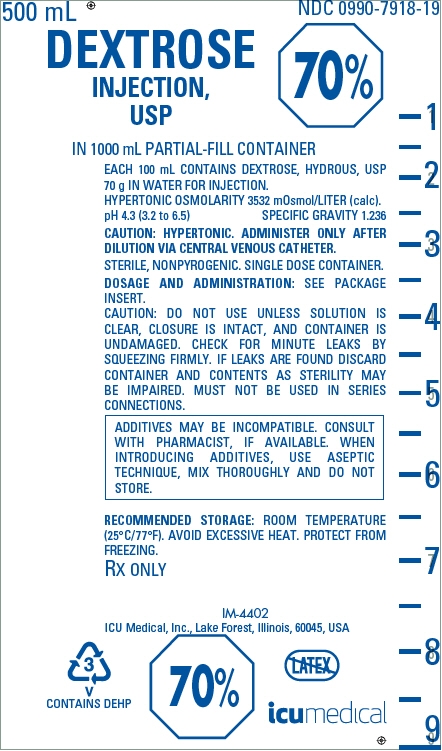
-
PRINCIPAL DISPLAY PANEL - 70 g/100 mL Bag Overwrap
TO OPEN — TEAR AT NOTCH
The overwrap is a moisture and oxygen barrier. Do not remove
unit from overwrap until ready for use. Visually inspect
overwrap for tears or holes. Discard unit if overwrap is
damaged. Use unit promptly when pouch is opened. Store at
20 to 25°C (68 to 77°F). [See USP Controlled Room
Temperature.] Protect from freezing. See insert. After
removing the overwrap, check for minute leaks by squeezing
container firmly. If leaks are found, discard solution as sterility
may be impaired.Rx only
WR-0551
ICU Medical, Inc., Lake Forest, Illinois, 60045, USA
icumedical
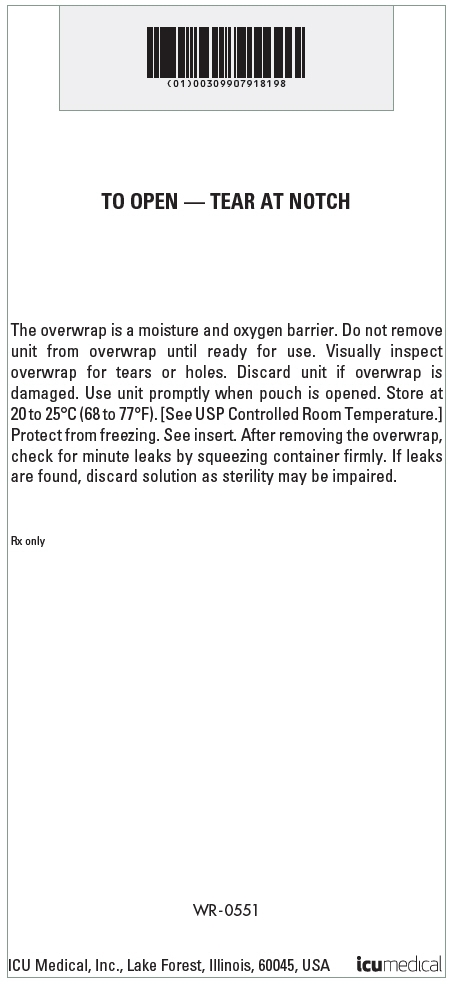
-
PRINCIPAL DISPLAY PANEL - 20 g/100 mL Bag Label
500 mL
IN 1000 mL PARTIAL-FILL CONTAINERNDC: 0990-7935-19
20% DEXTROSE
Injection, USPEACH 100 mL CONTAINS DEXTROSE,
HYDROUS 20 g IN WATER FOR INJECTION.
1009 mOsmol/LITER (CALC.)
pH 4.3 (3.2 to 6.5)
CAUTION: HYPERTONIC. ADMINISTER
ONLY AFTER DILUTION. DEXTROSE
SOLUTIONS WITHOUT SALTS SHOULD
NOT BE USED IN BLOOD TRANSFUSIONS
BECAUSE OF POSSIBLE ROULEAU
FORMATION.ADDITIVES MAY BE INCOMPATIBLE.
CONSULT WITH PHARMACIST, IF
AVAILABLE. WHEN INTRODUCING
ADDITIVES, USE ASEPTIC
TECHNIQUE, MIX THOROUGHLY AND
DO NOT STORE.SINGLE-DOSE CONTAINER. FOR
INTRAVENOUS USE. USUAL DOSAGE:
SEE INSERT. STERILE, NONPYROGENIC.
USE ONLY IF SOLUTION IS CLEAR AND
CONTAINER IS UNDAMAGED. MUST
NOT BE USED IN SERIES CONNECTIONS.Rx ONLY
3
v
CONTAINS DEHPicumedical
IM-4404
ICU Medical, Inc., Lake Forest, Illinois, 60045, USA
-
PRINCIPAL DISPLAY PANEL - 20 g/100 mL Bag Overwrap
TO OPEN — TEAR AT NOTCH
The overwrap is a moisture and oxygen barrier. Do not remove
unit from overwrap until ready for use. Visually inspect
overwrap for tears or holes. Discard unit if overwrap is
damaged. Use unit promptly when pouch is opened.
Store at 20 to 25°C (68 to 77°F). [See USP Controlled Room
Temperature.] Protect from freezing. See insert. After removing
the overwrap, check for minute leaks by squeezing container
firmly. If leaks are found, discard solution as sterility may be
impaired.Rx only
WR-0552
ICU Medical, Inc., Lake Forest, Illinois, 60045, USA
icumedical
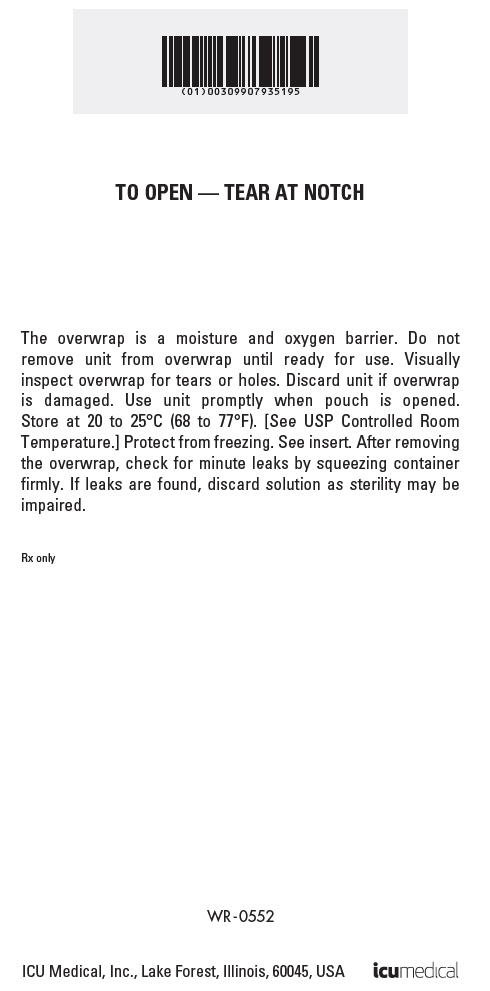
-
PRINCIPAL DISPLAY PANEL - 50 g/100 mL Bag Label
500 mL
NDC: 0990-7936-19DEXTROSE
INJECTION,
USP50%
IN 1000 mL PARTIAL-FILL CONTAINER
EACH 100 mL CONTAINS DEXTROSE, HYDROUS, USP
50 g IN WATER FOR INJECTION.
HYPERTONIC OSMOLARITY 2523 mOsmol/LITER (calc).
pH 4.3 (3.2 to 6.5)
SPECIFIC GRAVITY 1.170
CAUTION: HYPERTONIC. ADMINISTER ONLY AFTER
DILUTION VIA CENTRAL VENOUS CATHETER.
STERILE, NONPYROGENIC. SINGLE DOSE CONTAINER.
DOSAGE AND ADMINISTRATION: SEE PACKAGE
INSERT.
CAUTION: DO NOT USE UNLESS SOLUTION IS
CLEAR, CLOSURE IS INTACT, AND CONTAINER IS
UNDAMAGED. CHECK FOR MINUTE LEAKS BY
SQUEEZING FIRMLY. IF LEAKS ARE FOUND DISCARD
CONTAINER AND CONTENTS AS STERILITY MAY
BE IMPAIRED. MUST NOT BE USED IN SERIES
CONNECTIONS.ADDITIVES MAY BE INCOMPATIBLE. CONSULT
WITH PHARMACIST, IF AVAILABLE. WHEN
INTRODUCING ADDITIVES, USE ASEPTIC
TECHNIQUE, MIX THOROUGHLY AND DO NOT
STORE.RECOMMENDED STORAGE: ROOM TEMPERATURE
(25°C/77°F). AVOID EXCESSIVE HEAT. PROTECT FROM
FREEZING.Rx ONLY
IM-4433
ICU Medical, Inc., Lake Forest, Illinois, 60045, USA3
v
CONTAINS DEHP50%
icumedical
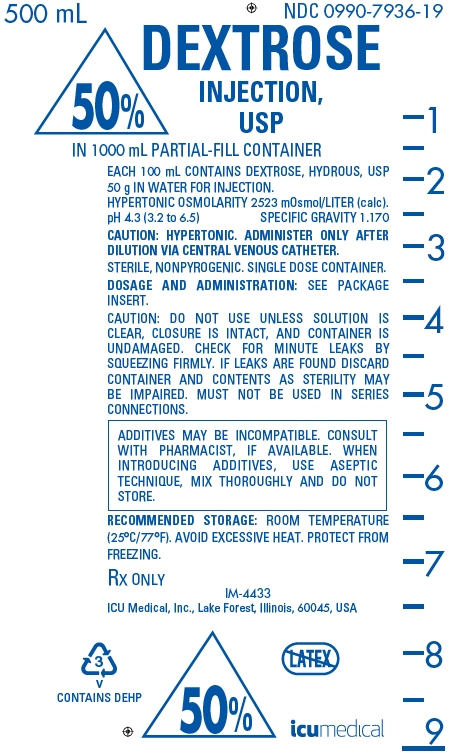
-
PRINCIPAL DISPLAY PANEL - 50 g/100 mL Bag Overwrap
TO OPEN — TEAR AT NOTCH
The overwrap is a moisture and oxygen barrier. Do not remove
unit from overwrap until ready for use. Visually inspect
overwrap for tears or holes. Discard unit if overwrap is
damaged. Use unit promptly when pouch is opened. Store at
20 to 25°C (68 to 77°F). [See USP Controlled Room
Temperature.] Protect from freezing. See insert. After
removing the overwrap, check for minute leaks by squeezing
container firmly. If leaks are found, discard solution as sterility
may be impaired.Rx only
WR-0555
ICU Medical, Inc., Lake Forest, Illinois, 60045, USA
icumedical
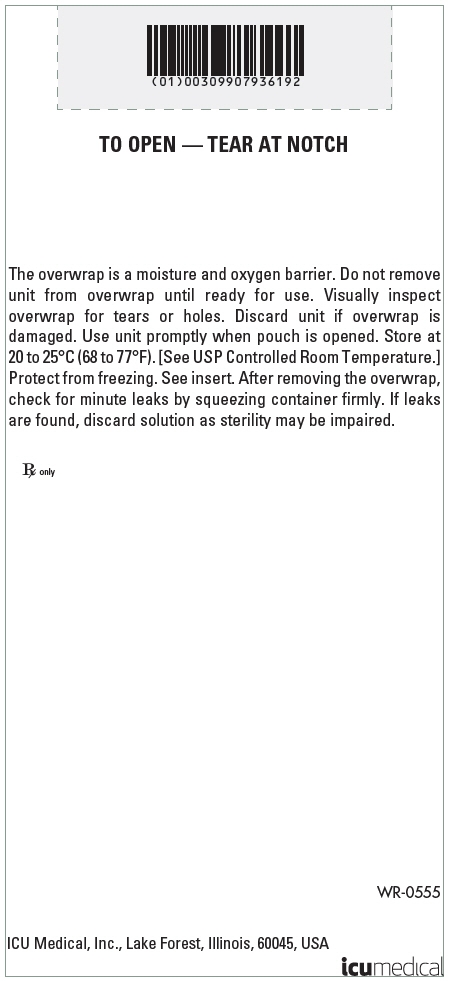
-
PRINCIPAL DISPLAY PANEL - 40 g/100 mL Bag Label
500 mL
IN 1000 mL PARTIAL-FILL CONTAINERNDC: 0990-7937-19
40% DEXTROSE
Injection, USPEACH 100 mL CONTAINS DEXTROSE,
HYDROUS 40 g IN WATER FOR INJECTION.
2018 mOsmol/LITER (CALC.)
pH 4.3 (3.2 to 6.5)
CAUTION: HYPERTONIC. ADMINISTER ONLY
AFTER DILUTION VIA CENTRAL VENOUS
CATHETER. DEXTROSE SOLUTIONS
WITHOUT SALTS SHOULD NOT BE USED
IN BLOOD TRANSFUSIONS BECAUSE OF
POSSIBLE ROULEAU FORMATION.ADDITIVES MAY BE INCOMPATIBLE.
CONSULT WITH PHARMACIST, IF
AVAILABLE. WHEN INTRODUCING
ADDITIVES, USE ASEPTIC TECHNIQUE,
MIX THOROUGHLY AND DO NOT STORE.SINGLE-DOSE CONTAINER. FOR
INTRAVENOUS USE. USUAL DOSAGE: SEE
INSERT. STERILE, NONPYROGENIC. USE
ONLY IF SOLUTION IS CLEAR AND
CONTAINER IS UNDAMAGED. MUST NOT
BE USED IN SERIES CONNECTIONS.Rx ONLY
3
v
CONTAINS DEHPicumedical
IM-4434
ICU Medical, Inc., Lake Forest, Illinois, 60045, USA
-
PRINCIPAL DISPLAY PANEL - 40 g/100 mL Bag Overwrap
TO OPEN — TEAR AT NOTCH
The overwrap is a moisture and oxygen barrier. Do not remove
unit from overwrap until ready for use. Visually inspect
overwrap for tears or holes. Discard unit if overwrap is
damaged. Use unit promptly when pouch is opened. Store at
20 to 25°C (68 to 77°F). [See USP Controlled Room
Temperature.] Protect from freezing. See insert. After removing
the overwrap, check for minute leaks by squeezing container
firmly. If leaks are found, discard solution as sterility may be
impaired.Rx only
WR-0557
ICU Medical, Inc., Lake Forest, Illinois, 60045, USA
icumedical
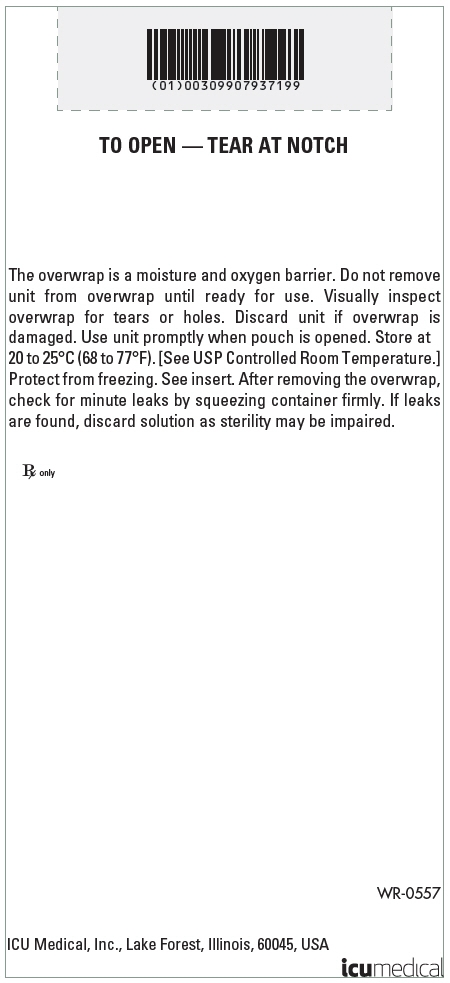
-
PRINCIPAL DISPLAY PANEL - 30 g/100 mL Bag Label
500 mL
IN 1000 mL PARTIAL-FILL CONTAINERNDC: 0990-8004-15
30% DEXTROSE
Injection, USPEACH 100 mL CONTAINS DEXTROSE,
HYDROUS 30 g IN WATER FOR INJECTION.
1514 mOsmol/LITER (CALC.)
pH 4.3 (3.2 to 6.5)
CAUTION: HYPERTONIC. ADMINISTER
ONLY AFTER DILUTION VIA CENTRAL
VENOUS CATHETER. DEXTROSE
SOLUTIONS WITHOUT SALTS SHOULD
NOT BE USED IN BLOOD TRANSFUSIONS
BECAUSE OF POSSIBLE ROULEAU
FORMATION.ADDITIVES MAY BE INCOMPATIBLE.
CONSULT WITH PHARMACIST, IF
AVAILABLE. WHEN INTRODUCING
ADDITIVES, USE ASEPTIC TECHNIQUE,
MIX THOROUGHLY AND DO NOT
STORE.SINGLE-DOSE CONTAINER. FOR
INTRAVENOUS USE. USUAL DOSAGE:
SEE INSERT. STERILE, NONPYROGENIC.
USE ONLY IF SOLUTION IS CLEAR AND
CONTAINER IS UNDAMAGED. MUST
NOT BE USED IN SERIES CONNECTIONS.Rx ONLY
3
v
CONTAINS DEHPIM-4436
ICU Medical, Inc., Lake Forest, Illinois, 60045, USAicumedical
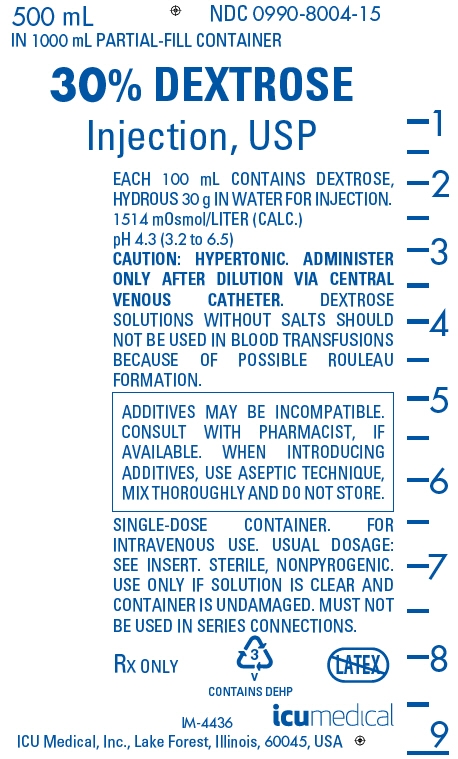
-
PRINCIPAL DISPLAY PANEL - 30 g/100 mL Bag Overwrap
TO OPEN — TEAR AT NOTCH
The overwrap is a moisture and oxygen barrier. Do not remove
unit from overwrap until ready for use. Visually inspect
overwrap for tears or holes. Discard unit if overwrap is
damaged. Use unit promptly when pouch is opened. Store at
20 to 25°C (68 to 77°F). [See USP Controlled Room
Temperature.] Protect from freezing. See insert. After removing
the overwrap, check for minute leaks by squeezing container
firmly. If leaks are found, discard solution as sterility may be
impaired.Rx only
WR-0560
ICU Medical, Inc., Lake Forest, Illinois, 60045, USA
icumedical
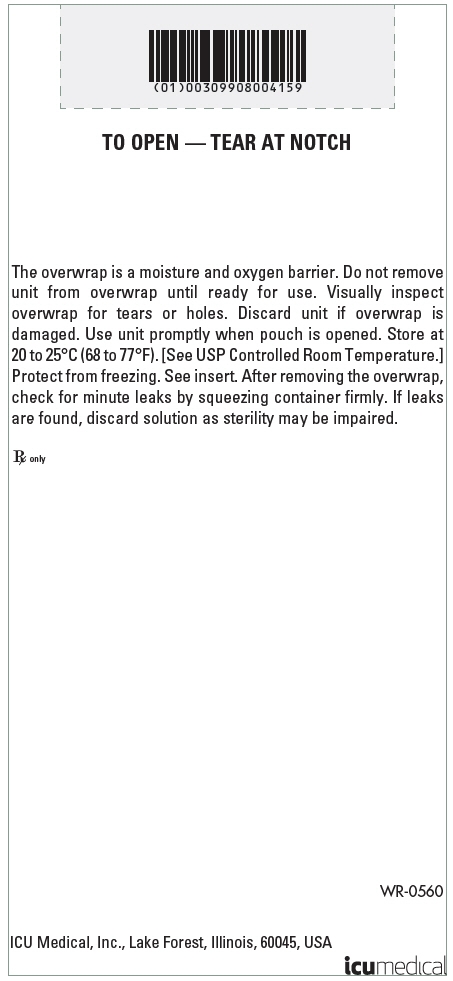
-
INGREDIENTS AND APPEARANCE
DEXTROSE
dextrose injection, solutionProduct Information Product Type HUMAN PRESCRIPTION DRUG Item Code (Source) NDC: 0990-7918 Route of Administration INTRAVENOUS Active Ingredient/Active Moiety Ingredient Name Basis of Strength Strength DEXTROSE MONOHYDRATE (UNII: LX22YL083G) (ANHYDROUS DEXTROSE - UNII:5SL0G7R0OK) DEXTROSE MONOHYDRATE 70 g in 100 mL Inactive Ingredients Ingredient Name Strength WATER (UNII: 059QF0KO0R) Packaging # Item Code Package Description Marketing Start Date Marketing End Date 1 NDC: 0990-7918-19 12 in 1 CASE 10/01/2019 1 1 in 1 POUCH 1 500 mL in 1 BAG; Type 0: Not a Combination Product Marketing Information Marketing Category Application Number or Monograph Citation Marketing Start Date Marketing End Date NDA NDA018561 10/01/2019 DEXTROSE
dextrose injection, solutionProduct Information Product Type HUMAN PRESCRIPTION DRUG Item Code (Source) NDC: 0990-7935 Route of Administration INTRAVENOUS Active Ingredient/Active Moiety Ingredient Name Basis of Strength Strength DEXTROSE MONOHYDRATE (UNII: LX22YL083G) (ANHYDROUS DEXTROSE - UNII:5SL0G7R0OK) DEXTROSE MONOHYDRATE 20 g in 100 mL Inactive Ingredients Ingredient Name Strength WATER (UNII: 059QF0KO0R) Packaging # Item Code Package Description Marketing Start Date Marketing End Date 1 NDC: 0990-7935-19 12 in 1 CASE 10/01/2019 1 1 in 1 POUCH 1 500 mL in 1 BAG; Type 0: Not a Combination Product Marketing Information Marketing Category Application Number or Monograph Citation Marketing Start Date Marketing End Date NDA NDA018564 10/01/2019 DEXTROSE
dextrose injection, solutionProduct Information Product Type HUMAN PRESCRIPTION DRUG Item Code (Source) NDC: 0990-7936 Route of Administration INTRAVENOUS Active Ingredient/Active Moiety Ingredient Name Basis of Strength Strength DEXTROSE MONOHYDRATE (UNII: LX22YL083G) (ANHYDROUS DEXTROSE - UNII:5SL0G7R0OK) DEXTROSE MONOHYDRATE 50 g in 100 mL Inactive Ingredients Ingredient Name Strength WATER (UNII: 059QF0KO0R) Packaging # Item Code Package Description Marketing Start Date Marketing End Date 1 NDC: 0990-7936-19 12 in 1 CASE 10/01/2019 1 1 in 1 POUCH 1 500 mL in 1 BAG; Type 0: Not a Combination Product Marketing Information Marketing Category Application Number or Monograph Citation Marketing Start Date Marketing End Date NDA NDA018563 10/01/2019 DEXTROSE
dextrose injection, solutionProduct Information Product Type HUMAN PRESCRIPTION DRUG Item Code (Source) NDC: 0990-7937 Route of Administration INTRAVENOUS Active Ingredient/Active Moiety Ingredient Name Basis of Strength Strength DEXTROSE MONOHYDRATE (UNII: LX22YL083G) (ANHYDROUS DEXTROSE - UNII:5SL0G7R0OK) DEXTROSE MONOHYDRATE 40 g in 100 mL Inactive Ingredients Ingredient Name Strength WATER (UNII: 059QF0KO0R) Packaging # Item Code Package Description Marketing Start Date Marketing End Date 1 NDC: 0990-7937-19 12 in 1 CASE 10/01/2019 1 1 in 1 POUCH 1 500 mL in 1 BAG; Type 0: Not a Combination Product Marketing Information Marketing Category Application Number or Monograph Citation Marketing Start Date Marketing End Date NDA NDA018562 10/01/2019 DEXTROSE
dextrose injection, solutionProduct Information Product Type HUMAN PRESCRIPTION DRUG Item Code (Source) NDC: 0990-8004 Route of Administration INTRAVENOUS Active Ingredient/Active Moiety Ingredient Name Basis of Strength Strength DEXTROSE MONOHYDRATE (UNII: LX22YL083G) (ANHYDROUS DEXTROSE - UNII:5SL0G7R0OK) DEXTROSE MONOHYDRATE 30 g in 100 mL Inactive Ingredients Ingredient Name Strength WATER (UNII: 059QF0KO0R) Packaging # Item Code Package Description Marketing Start Date Marketing End Date 1 NDC: 0990-8004-15 12 in 1 CASE 10/01/2019 1 1 in 1 POUCH 1 500 mL in 1 BAG; Type 0: Not a Combination Product Marketing Information Marketing Category Application Number or Monograph Citation Marketing Start Date Marketing End Date NDA NDA019345 10/01/2019 Labeler - ICU Medical Inc. (118380146)
© 2025 FDA.report
This site is not affiliated with or endorsed by the FDA.
